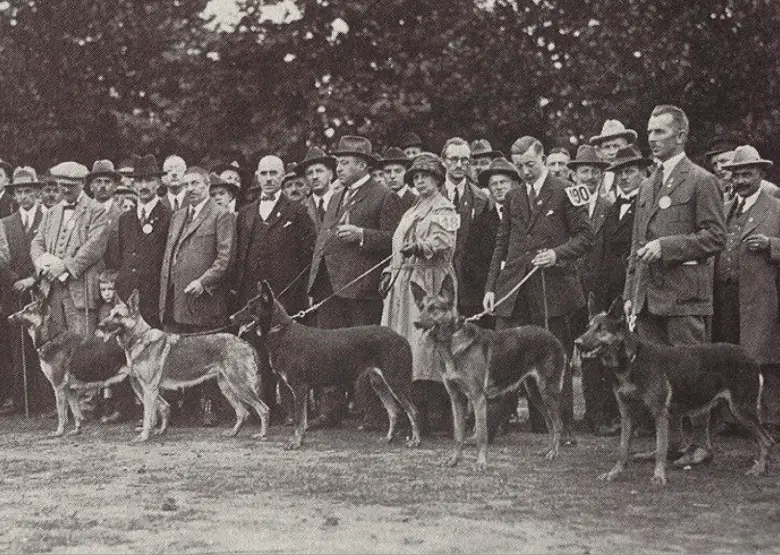Table of Contents
Admired and respected, the working-class German Shepherd dog has been one of the most coveted dog breeds worldwide. Originating in Germany, the GSD proved to be excellent guardians and sheep herders in their earliest uses. This was the start of the history of the German Shepherd, setting them apart as a unique working breed. They were, and have remained to this day, valued for their superior intelligence, ease of training, alertness, and muscular stamina.
Officially introduced and recognized as a standard breed in 1899 by Captain Max Von Stephanitz, the German Shepherd’s history is filled with diverse roles. This highly intelligent breed has been widely used in police work, as companions to the blind, as search and rescue dogs, and in security, herding, K9, and wartime participation. Today, the dog takes up 4.6 percent of the canine population among all registered breeds with the American Kennel Club. It can be recognized that Max von Stephanitz was the most important contributor to the history of the GSD.
Key Takeaways of The German Shepherd Dog History
- Original German Shepherd dogs in mid-1800s Germany were various herding and guardian dogs with no breed standardization.
- Phylax Society was formed in 1891 to create a standardized GSD breed but disagreed on prioritizing appearance vs working ability and disbanded in 1894.
- Max von Stephanitz pivotal in creating the breed, purchased Hektor Linksrhein in 1899 and renamed him Horand von Grafrath, the first registered German Shepherd.
- Von Stephanitz established the Society for the German Shepherd Dog (SV) in 1899 and created breed standards emphasizing intelligence and working ability.
- Horand and his offspring Hektor von Schwaben bred with Horand’s female descendants to produce the influential dog, Beowulf. Beowulf and his related bloodline are the German Shepherd ancestors of all dogs of this breed today.
- Von Stephanitz used extensive inbreeding and line-breeding to establish breed type and standard quickly.
- The first German Shepherd dog was exhibited in America in 1907; popularity grew through Rin Tin Tin and other dog actor celebrities.
- The breed was widely used in both World Wars as messenger dogs, mine detectors, search and rescue, etc.
- Post-war, the breed continued development in Germany under SV, with an emphasis on working ability and training tests.
- The impact of the American market increased focus on dogs’ appearance while maintaining working abilities. America relied more on a free-breeding approach, while Germany strictly controlled breeding via the SV system and standards.
- Max von Stephanitz is well-regarded for dedicating his life’s work to establishing and protecting the German Shepherd breed. His breeding produced a globally admired, intelligent working breed with versatility beyond just herding.
- The GSD is now one of the most popular breeds in the world.
Original German Shepherd Dogs in Germany in the mid-1800s
Purebred dogs and dog shows exploded in popularity all across Europe in the mid-1800s. New dog breeds were being defined and introduced into the show ring in unprecedented numbers. In Germany, where historically the value of a dog was based upon its utility and not what it looked like or whether it fits a breed standard, there were numerous different types of dogs working as shepherds and guardians in different parts of the country. Many were exceptional in their roles, but there was little uniformity in their size, appearance, or performance capability.
The GSD was first used as a working dog in the mountainous pastures of Germany, where herders needed an agile and competent dog to guard their sheep. This dog stood out as the most agile, intelligent, and faithful dog among other breeds, which were also used in this capacity.
Phylax Society
Formed in 1891, the Phylax Society was an attempt to create a standardized list of dog breeds in Germany. The society disbanded after three years of internal conflict over the most important traits of standardization—appearance and working ability.
The Phylax Society Gets Started
In 1891, a group of German dog fanciers got together with the intent of developing a distinct and uniquely German breed of shepherds. They called themselves the Phylax Society, a Greek word meaning “guardian” or “guardsman,” and they set about searching for dogs to fit their idea of the perfect canine. Unfortunately, they had only a vague idea of what they thought the perfect canine should be.
The biggest challenge faced by the Phylax Society was not a lack of quality dogs upon which to build a new, spectacular breed of dogs, but an inability to agree upon the traits that the perfect canine should possess. Some members felt that the dog’s physical appearance mattered little as long as it could perform the tasks set to it with great agility and endurance. Others held that a conformation standard was most important, stressing beauty, or at least consistency of type, over ability. A few believed it was possible to have both beauty and physical talent, and asserted that they would settle for nothing less.
Phylax Society Disbands
Through the mating of several dogs that fit no fully defined standard, the Phylax Society attempted to create a new German breed, but without success. Unclear whether beauty or brawn should prevail, they produced neither. Disappointed and frustrated, members began leaving the Society, and in 1894, it was disbanded entirely.
However, the dream of creating the original German Shepherd breed did not die with the Phylax Society. A few of the members never lost sight of their goal, and one man, in particular, was poised to take up the cause in a decisive way.
Max von Stephanitz
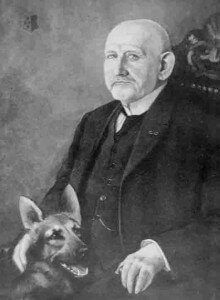
Max Emil Friedrich von Stephanitz, credited with being the founder of the German Shepherd dog as a distinct breed, was born on December 30, 1864, in Dresden, Germany. His family ranked among the nobility, and his family expected that he would become a military officer, even though he wanted to work in agriculture. He followed his family’s wishes and ended up a career officer with the cavalry. This one choice proved to be pivotal, as it enabled Von Stephanitz to travel the country where he encountered a variety of working shepherd dogs.
Later, he took a course at the Berlin Veterinary College, where he learned about biology, anatomy, and an area of study that some call “form to function,” which is the science of movement based on conformation. During that time, he also gained much experience working with the Berlin Veterinary Hospital, which certainly influenced the formation of his ideas about what would comprise the ideal working dog.
Von Stephanitz was an original member of the Phylax Society and felt that a superior German breed of herding dogs could be developed. The British were using breeding and culling techniques that they had developed to great success, and von Stephanitz believed he could do the same with German dogs.
Once he retired from the military, Von Stephanitz purchased property near Grafrath in the 1890s and began experimenting with dog breeding. He was a common sight at dog shows and herding trials in Germany, where he observed that there were many quality dogs at the shows, but there was no standardization of type. Among the competitors exhibited, he preferred the wolf-like dogs with pricked ears and keen senses, possessing exceptional intelligence and willingness to work. He believed that by mating together superior dogs with these traits, he could establish an admirable breed for livestock herding and guarding throughout Germany.
Max Von Stephanitz realized that the ideal working dog would need to be physically built for endurance as well as speed. Since a typical shepherd would be expected to keep a flock of over 200 sheep under control, the dog would need to be intelligent, obedient, and tireless. He would need to be courageous and have a strong instinctive nature toward protectiveness. He preferred that the classification be regulated to the dog’s working ability and characteristics rather than appearance. Von Stephanitz’s criteria called for a dog that could reason, even-tempered, agile, strong, and protective of its owner and stock.
In 1889, Max von Stephanitz attended a dog show in Karlsruhe, Western Germany in 1889 where a particular working dog caught his interest. Its name was Hektor Linksrhein and it demonstrated a powerful endurance, keen intelligence, and steady disposition. This particular dog was yellow and gray, mirroring the appearance of a wolf. This dog named Hektor was set to become a significant part of the German Shepherd family tree.
Believing he had finally found the dog that encompassed so many of the characteristics he was looking for, the man quickly purchased the dog for the handsome sum of 200 German gold marks and renamed him Horand von Grafrath. This very dog became the first German Shepherd dog in 1889, marking a pivotal moment in the history of the German Shepherd breed. Upon its foundation, Max von Stephanitz developed what is now known as the modern-day GSD.
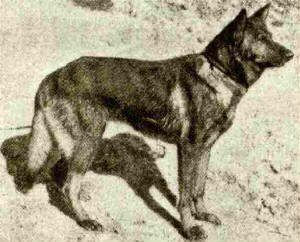
Origin of German Shepherd Breed
In the evolution of the German Shepherd Dog, Von Stephanitz relied heavily on inbreeding, tasking Horand and his brother, Luchs, with expanding the lineage through half-sisters and sons’ daughters. Three prime dogs resulted from the breeding: Heinz von Starkenberg, Pilot III, and Beowulf. Soon, unrelated bloodlines were introduced, which possessed herding origins, eventually expanding the bloodline.

Maintaining the German Shepherd’s Family Tree: The Role of Household Breeding
Max von Stephanitz believed that the ideal breeders of German shepherds would be families with only a couple of breeding dogs to facilitate daily contact with the dogs as a way of carefully choosing the dogs which would enhance the breed in the future.
He argued,
“All the wonderful qualities of character possessed by a good shepherd dog will therefore only be brought to light when he remains in the same hands for a very long time, preferably from puppyhood, where having obtained a footing in the house, he shares the joys and sorrows of the family…and our dog is completely ruined in mind and body wherever he is treated only as merchandise….”
Along these same lines, Max von Stephanitz did not believe in maintaining dogs in kennels regularly and pointed out that such would necessarily result in dogs that would be unable to perform to their utmost ability.
“Whenever the dog is kept in an enclosed kennel, he will not only degenerate physically, becoming stiff, sluggish and lazy but will also become mentally torpid and lose all his sharpness and vim.”
Breeding Methods and Outcomes
Significant work has been undertaken in the German Shepherd breed history to establish this new breed. Here are the most important stages and principles of breeding introduced by von Stephanitz.
Creation of the Breed Standard
After obtaining Horand, Max von Stephanitz worked to develop a standard for the breed. He created a studbook for GSD, registering Horand as the first stud dog.
Max von Stephanitz, drawing upon his experiences with the Berlin Veterinary Hospital as well as his observations, began a serious breeding program. Choosing dogs with desirable traits, he devoted years to establishing a recognizable breed type, focusing on the dog’s abilities as a working dog. He also worked diligently to cull out physical traits which would weaken the breed as a whole.
Versatility in the Evolution of the German Shepherd Breed
Max von Stephanitz recognized a need to integrate German Shepherds into other areas of society and became a strong advocate for using the dog in military service, law enforcement, protection service, and rescue efforts. Von Stephanitz championed the resulting breed to serve in various branches of government service that would take advantage of its versatility. This included tasks in supply carrying, tracking, courier service, guard positions, and Red Cross duties.
Always looking for ways to protect and improve the breed, Von Stephanitz paid close attention to trends in breeding and worked tirelessly to maintain the standard for which he is so well recognized. Discouraging breeding for beauty instead of purpose, Von Stephanitz’s motto was:
“Utility is the true criterion of beauty.”
Mating Combinations: Understanding the German Shepherd Ancestry
The most lasting and notable mating combination of the GSD by von Stephanitz was an offspring of Horand, named Hektor von Schwaben. Hektor was inbred with another one of Horand’s offspring, and this produced Beowulf. Beowulf produced 84 pups, mostly matings from Hektor’s other offspring. Beowulf and his related bloodline are the German Shepherd ancestors of all dogs of this breed today, mostly owing to the efforts and attentive care of Max von Stephanitz. This was a huge factor in German Shepherd history and today’s further development of the breed.
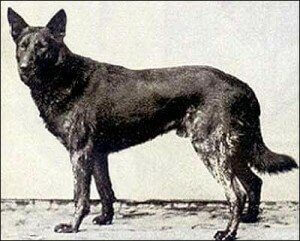
Society for the German Shepherd Dog (SV)
Von Stephanitz cannot be credited with single-handedly creating the foundation stock of the newly emerging GSD, since Horand was himself the product of generations of selective breeding before von Stephanitz bought him. However, von Stephanitz was able to spot the dog’s qualities from among all of the many specimens he saw regularly and calculate his potential as a breeding animal.
On April 22, 1899, von Stephanitz was inspired to form a new organization, which he called Verein fur Deutsche Schaferhunde, or the Society for the German Shepherd Dog, commonly known as the SV. Along with long-time friend and co-founder Adolf Meyer, von Stephanitz recruited three sheep masters, two factory owners, an architect, an innkeeper, a mayor, and a magistrate to the SV.
Von Stephanitz became the first president of the organization. He established the first criteria for the recognition of the breed. His motto was “Utility and Intelligence.” He devised a blueprint that dictated the overall morphology, gait, and temperament, which became the primary identifiers for the breed.
Right away, the SV established a breed standard against which all GSDs would be judged, along with a Breed Register to record bloodlines. The dog that von Stephanitz purchased earlier, Horand von Grafrath, was recorded as the first German Shepherd Dog in the new registry.
A Grand Design: The Original German Shepherd’s Birth
Max von Stephanitz aimed for more than just breeding fine dogs; he aspired to shape the German Shepherd’s breed origin. He wanted a place in history. Taking what he had learned from his studies at the Berlin Veterinary College and through experience gleaned from his own prior dog breeding endeavors, he began a program of what some consider to be a rather ruthless approach to achieving goals. Ruthless or not, the steps taken by von Stephanitz in an era when genetics and DNA testing were not available proved to be almost prescient in their accuracy in extracting the best qualities of the dogs he bred and eliminating the unacceptable strains.
Von Stephanitz knew that, to set a certain “type,” dogs with similar backgrounds and traits must be bred together over several generations. He did not care to wait that long. To speed the process and to capitalize on the valuable qualities of his treasured stud dog, Horand, von Stephanitz quite intentionally implemented a process of line breeding and inbreeding to quickly stamp successive generations of puppies with the “right stuff.”
Inbreeding and Line Breeding: Shaping the German Shepherd Ancestry
People knowledgeable in animal husbandry understand that breeding like to like is the only way to establish consistent results when raising any type of animal. Every distinct species in existence owes its heritage to the concentration of its genes through either inbreeding or line breeding.
Although frowned upon in some circles, inbreeding is the fastest way to concentrate genes. This method implies pairing close relatives such as brothers to sisters, fathers to daughters, mothers to sons, etc.
Linebreeding is the pairing of less direct crosses, such as fathers to granddaughters or mothers to grandsons. The practice is still called line breeding even when the pairing is used for more distant relatives that are several generations removed.
Linebreeding and inbreeding, when practiced carefully and with purpose, have the potential to produce spectacular results in the development of sought-after traits. Both inbreeding and close-line breeding methods have their disadvantages as well. They are shunned by many breeders of all types of animals because along with a concentration of the good traits comes a concentration of the faults as well. It is to the credit of von Stephanitz that he understood which animals to select to continue the bloodline and which ones to cull without sentiment due to inferior qualities.
Project Implementation: Tracing the German Shepherd Family Tree
Von Stephanitz utilized both breeding techniques in pursuing what he called his “grand design,” marking a significant chapter in the German Shepherd history. His goal was to produce dogs with superior conformation, loyalty, obedience, and courage. Toward this end, Horand was bred extensively and produced many offspring. Horand’s most famous and successful son, Hektor von Schwaben, an important figure in the German Shepherd’s ancestors, was bred to female offspring of Horand, thus producing the famous and influential Beowulf, among others. Beowulf and his brothers were bred back to daughters and granddaughters of Hektor, and it is to these offspring of Horand and Beowulf that all modern GSDs can trace their ancestry.
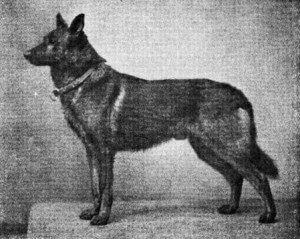
Because of the intense inbreeding of dogs early in the history of German Shepherd lines, the specific look and type that von Stephanitz was striving for became fixed in an amazingly short period. In particular, the pricked ears and the athletic, sloping angles of the shoulders, hips, and legs stamped his animals as the ‘German breed’.
Requirements and Control: The Evolution of German Shepherd Standards
Von Stephanitz knew, however, that he had to look for suitable unrelated dogs to create enough genetic diversity for the breed to survive. He did, of course, insist on remaining in complete control of choosing which dogs were registered and approved for breeding. Ultimately, he and the SV published the Korbuch, or Breed Survey Book, which was issued two decades after the founding of the SV. The Breed Survey Book detailed the guidelines to be followed when selecting GSDs for breeding.
Von Stephanitz also insisted that dogs judged in shows be held to the same standards and not selected simply on the judges’ preferences. He emphasized ‘utility and intelligence’, but according to many, the dogs bred or culled in the beginning were selected based mostly on looks. Until there were enough dogs of sufficient age to begin judging them on their athletic ability and work ethic. Fortunately, the progeny of Horand inherited more than his looks.
Continuing with his grand design, von Stephanitz educated breeders on the form to function athleticism. He essentially forced them to focus on the angle of the bones, the proportions, and measurements of the body and legs, and the overall conformation of the dogs they were raising. The SV sent representatives to inspect litters of puppies recommended for addition to the registry. Those puppies deemed too small, weak, or imperfect were ruthlessly culled. Sometimes culling took place based only on the number of puppies in a litter. If the self-titled SV Breeding Warrens deemed that there were too many puppies for the dam to raise them adequately, pups were culled based on appearance and gender, with a slant toward preserving larger, more robust males.
If by today’s standards, the methods of the SV seem harsh, it is important to remember that such methods were not considered abnormal in the period. Animals were bred and raised primarily for utility, and the techniques used to establish the GSD were considered normal husbandry. Certainly, the methods succeeded in creating a useful, recognizable breed in an amazingly short time.
The 1925 Sieger: A Significant Chapter in the History of German Shepherd Dog
By 1925, Germany held a national conformation show to determine the best male and female German Shepherd each year. By the end of the show, only one dog in each gender would receive the coveted title of Sieger. Many of the most influential breeders would arrange to breed their best bitches to that year’s Sieger dog, thus cementing the dog’s impact on the breed as a whole. Max von Stephanitz recognized this, and in 1925, while judging the annual Sieger show, he made a decision that impacted the breed forever.
Max von Stephanitz continued to wield much influence over which dogs were bred to continue the lines, even when he and the SV could not inspect every mating. As President of the SV, he reserved for himself the right to choose the Sieger and Siegeren, or Grand Champion male and female, at the SV’s largest specialty show every year. His selections let breed club members know which dogs he felt possessed suitable conformation and temperament to earn the right to produce offspring. Puppies from the Sieger and Siegeren became much sought after, thus ensuring that the breed type remained fixed.
Believing that the direction the German Shepherd breed was taking as a whole toward taller, boxy dogs was the wrong direction, Von Stephanitz awarded the year’s Sieger to a dog named Klodo von Boxberg. Klodo was a dramatic departure from the typical GSD at that year’s show. Where the other dogs were boxy, Klodo was long in the body. Slightly shorter than many of his peers, Klodo was nonetheless impressive, especially when his long-reaching gait was revealed. Klodo was a German Shepherd of impeccable movement, with a long, effortless stride. His impact on the breed as a whole continues to this day.
History of the German Shepherd Dogs in America
The German Shepherd dog breed was widely recognized and started conquering other realms. America was the primary destination.
America and the First Exhibition of the German Shepherd Dog
The year 1907 was well-remembered in German Shepherd history. It brought the first exhibition of the GSD in America. Mira von Offingen was imported by Otto Gross and exhibited by H. Dalrymple from Allegheny, Pennsylvania. The event was the open class at Newcastle and Philadelphia. Visitors and participants took immediate notice of this new breed. It wasn’t until 1913 that the GSD received its first championship award. In the same year, Anne Tracy and Benjamin Throop founded the German Shepherd Dog Club of America, attracting a small charter of 26 members. It was another big step in German Shepherd history.
Since Max von Stephanitz was sought after as an international judge in the early 1900s, he traveled to the United States in 1930. He was asked to serve as the German Shepherd judge at the Morris & Essex Kennel Club Show. This event was held at the estate of Geraldine Rockefeller Dodge. German Shepherd breeders were anxious for his opinion on their breeding stock resulting in a high entry of German Shepherds in the show. Max von Stephanitz had to judge the male dogs on the first day of the show and the bitches on the second day. He took this task very seriously, writing a personal critique on every single entry.
German Shepherd Dog Clubs in America: Expanding the German Shepherd Breed History in New Lands
The American German Shepherd dog club’s first show was held in Greenwich, Connecticut, in 1915. The club’s name was changed to the Shepherd Dog Club of America due to America’s entering the war and distancing itself from all things related to Germany. England opted for the breed name “Alsatian“. However, due to Germany’s success with the breed in the war, American veterans found favor with the dog’s intelligence and attractive appearance, bringing some of the dogs back with them.
Popularity and the Original German Shepherd’s Rise to Stardom
The American public soon embraced the breed. Still, it was the emergence of Rin-Tin-Tin, a rescued male GSD from the war, that graced the silent films of the day and shot the dog’s popularity through the roof. With the popularity of another GSD, Strongheart, the American public became smitten with the canine stars and began swarming the kennels in search of the dog for a family pet. The canine film stars became so popular that Darryl Zanuck of Warner Bros advanced in the film hierarchy. In a bit of irony, Rin-Tin-Tin garnered the most votes for a supporting actor during the Academy Awards in 1929. The dog was nixed from the ballot only because it did not qualify as a human contestant.

Indeed, the history of German Shepherds quickly ascended to global recognition thanks to Hollywood. Starting from the 1920s, such famous dogs as Rin Tin Tin and Braveheart paved the way for a long succession of canine heroes that extends into the present day. Hollywood almost proved to be the demise of the GSD as well, when unscrupulous breeders, determined to capitalize on the enthusiasm of the public to own this great dog, pumped out puppies with no care for conformation or temperament. Fortunately, groups of enthusiasts in Europe and America rescued a core population of quality breeding stock that revitalized the bloodlines.
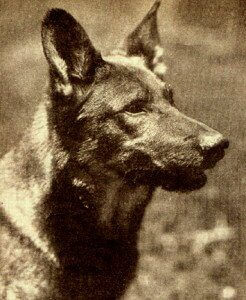
More Than a German Sheepdog
Under the guidance of Max von Stephanitz, the SV became a prominent figure in the original German Shepherd lineage, turning into the largest breeding club worldwide, but von Stephanitz was not satisfied. Realizing that industrialization would reduce shepherds’ reliance on sheepdogs and certain that GSDs possessed traits suitable for many different types of work, he pushed to have the dogs trained for new tasks. German Shepherds began competing in tracking and obedience, and in 1901, the first Schutzhund trial was held in Germany.
Remarkably, German Shepherds excelled at any task asked of them. By 1910, over 500 German police stations were using the dogs in various capacities, and it took little imagination to realize that they would be a seamless addition to the military. With the onset of World War I, German and French troops first began using dogs to search and rescue the wounded, which is the basis for present-day search and rescue activities. Their role quickly expanded, and soon they were being asked to carry messages, ammunition, first aid kits, and other supplies to the front lines. The dogs proved themselves to be brave, loyal, smart, and strong. They also served as sentries and guard dogs, and their presence was imposing. One of the most hazardous duties they were called upon to perform was locating mines and bombs. Their success in sniffing out mines led them to later be used to detect explosives and drugs in military and police work worldwide.
Their utility expanded beyond the trenches as they were trained to aid soldiers who were blinded during the war, lending blinded soldiers a “seeing eye.” During World War II, Allied soldiers fighting against the Germans were so impressed with the dogs that many were captured and taken out of the country when the war ended. Although GSDs continued to serve in their original role as herding animals, they found themselves being appointed to jobs in many walks of life.
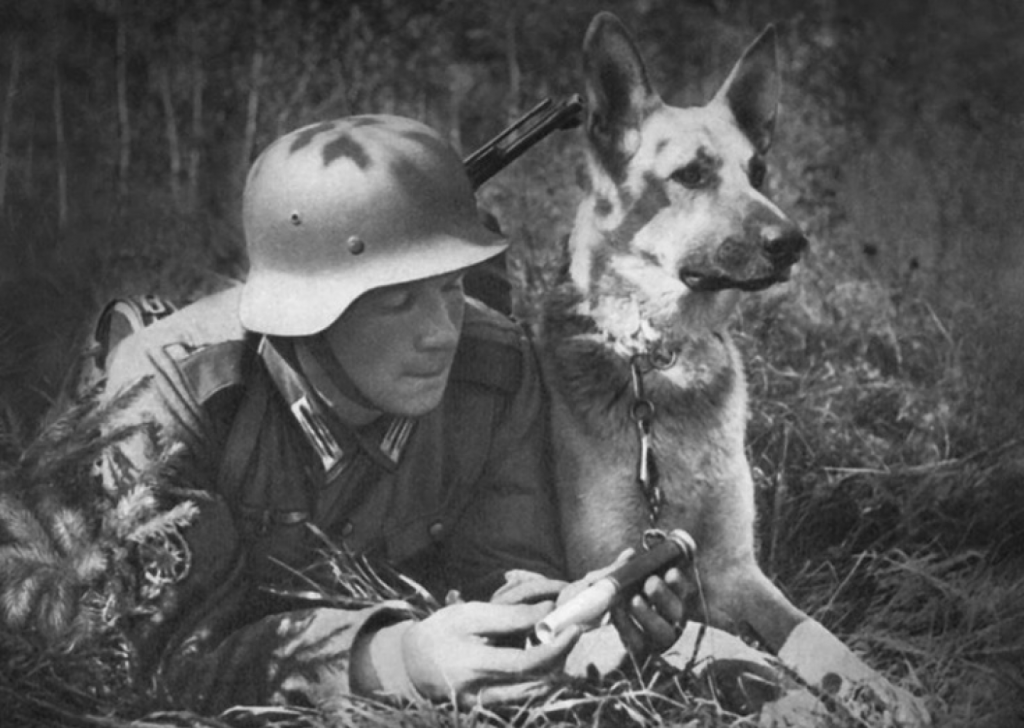
Max Emil Friedrich Von Stephanitz Shares His Experience
Reflecting on the German Shepherd ancestors, Max von Stephanitz determined that a working dog required several common traits, including intelligence, loyalty, and tireless devotion to completing the tasks required of him. It had taken him years to achieve his goal of creating a standard for the German Shepherd breed as a whole. He committed to sharing his knowledge and experience in writing. He published his book, calling it “The German Shepherd Dog in Word and Picture”. Written in 1925, translated by J. Schwabacher, and reprinted in 1994 by Hoflin Publishing, Von Stephanitz’s reference to the ideal dog is the following:
“Untiring, always zealous for duty, always attentive, always ready to serve, such is the character of our shepherd dog.”
Controversy of Max von Stephanitz
Nevertheless, there was a certain controversy associated with Max von Stephanitz. Rumors abounded that Horand was one-fourth wolf. Questions still exist today about whether Max von Stephanitz used dogs with wolf ancestors in his breeding program, as his original book listed wolves among breeding stock. In any case, Max von Stephanitz insisted on having all references to wolves removed from later printings of his book and actively encouraged breeders to refrain from using wolves as part of their breeding stock.
More Controversy of Max von Stephanitz
Another area of controversy that Max von Stephanitz dealt with was the color of German Shepherd dogs, particularly white shepherds. Grief, the grandsire of Horand, was a white shepherd, and Horand sired many white pups. With his emphasis on the suitability of the GSD to serve as a working dog, Max von Stephanitz was not greatly interested in the colors of the dogs he promoted.
Preserving the German Shepherd Origin and Breed Integrity in the Face of Adversity
In the 1930s, several prominent members of the Nazi party became actively involved in the German Shepherd Club in Germany. These members advocated a desire to produce attractive dogs. This philosophy was the antithesis of all that Max von Stephanitz had worked for, developing a dog known for his abilities rather than appearance. Max von Stephanitz staunchly maintained his position despite threats from the party,
“The breeding of Shepherd dogs must be the breeding of working dogs, this must always be the aim, or we shall cease to produce working dogs.”
However, Max von Stephanitz didn’t manage to persuade anyone, so he, who had always advocated utility over beauty, eventually resigned from the club. A year later, he passed away.
Maintaining his devotion to the dogs he loved throughout his life while tirelessly working to achieve the goal of preserving the breed as a working dog, Von Stephanitz will always be admired for his achievement and dedication. One of the most often quoted statements of Max von Stephanitz could indeed have been used as his epitaph:
“Take this trouble for me: Make sure my shepherd dog remains a working dog, for I have struggled all my life long for that aim.”
German Shepherd Dogs Incorporated Into the World War II Effort
By 1937, the German Shepherd breed had become more refined. The instinct was to incorporate the German Shepherd into the World War II effort. So the German shepherd dog’s history was changed once again. The dog found favor with both the Axis and Allied forces, used for mine detection, messenger, guard sentinels, and other tasks. The Army enlisted several thousand dogs for service. Due to a substantial loss of dogs in the war from hunger and casualties, a concerted effort was made to preserve the best of the inbreed and line-breeds to continue a quality bloodline.
By 1949, quality dogs that had survived the war began to emerge at GSD shows. The selected post-war dogs, many of them products of superior sires, began to take on qualities of enhanced appearance while retaining the genes of the active war dog lines.
Post-War Shifts in the German Shepherd Lineage
The new pedigrees of GSDs resulted from the infusion of out-cross blood, and by the 1950s, America began the blended breeding technique. The results eventually produced a stronger emphasis on high-quarter strength, upper leg strength, and increased muscle and bone density. The cropped ears and head began to take on a more pleasing, standardized appearance, increasing the German Shepherd dog’s show qualities. Troll von Richterbach, a 1957 Grand Victor dog, was hugely influential in producing the finest qualities found in the German Shepherd history of the breed.
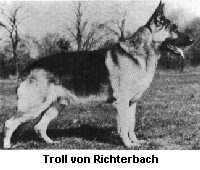
The most influential GSD import breeds to America in America’s German Shepherd breed history were Falk v Eningsfeld and Bernd v Kallengarten. Ernie Loeb brought both in. Both dogs possessed dominant qualities for bones, feet, suspension, forehand, shoulder, tail set, head, crop, and body length. There were occasional problems with weaknesses in the ears, steep, loose ligament structure, long coats, and elbow and hip dysplasia.
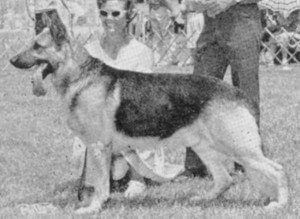

The 1960s introduced a revival of practices where American breeders followed their whims and preferences. This time produced some of the best stud lines, bringing about the emergence of the “F” line, with such dogs as Field Marshall, Fels, Fortune and Fashion, and others bred by Lucy Woodard. One notable GSD, Lance of Fran-Jo, an American-Canadian Grand Victor, enhanced the line further by accentuating side gait, topline, and angulation traits. Lance was widely bred in America, negating the need for quality imports. Lance’s descendants populated the 1970s and became America’s unique foundation and German Shepherd dog breed lineage.
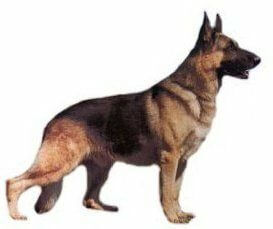
Project’s Further Development in Germany and Its Outcomes
Germany, controlled by the SV, had a more strict breeding program in place from the start, introducing the “A” stamp, a tattoo I.D system. GSDs were highly sought after by South America, France, Italy, Japan, and the Scandinavian countries. This required stricter top-rating regulations for the entire bloodline.
From this quality control stance, some of the most notable sires came, including Quanto Wienerau, Mutz vd Pelztierfarm, Marko v CellerLand, and Canto Wienerau. Quanto remained a popular producer, creating the best qualities of the forequarter, bone, and head morphology, along with desirable cow hocks and long and short croup in the GSD. Canto only lived for four years but passed on superior traits in energy, style, and fluidity of movement, which appealed to the international audience. The mating of the Quanto, traditional, and Canto lines yielded Canto Arminius, a very substantial and dominant influence in the breed as well as a heavy influence on German Shepherd history.
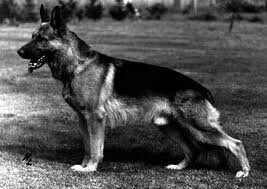

Reflecting on the German Shepherd breed history, the SV demanded more relevance in training degrees in the 1960s. Emphasis was placed on tests, such as courage and the AD endurance test. Minimum quality requirements were instituted, forcing breeders to concentrate on dental defects, problems with croups, and other less obvious features. The Schutzhund 3 degree of quality became mandatory for any of the prestigious VA awards. Breeders had no choice but to conform to the guidelines since the SV officials at the Sieger show events were also the judges in charge of scoring. From the 1980s and on, the SV has remained in relatively tight control of the breeding and awards systems for the German Shepherd breed.
FAQ on GSD Breed History
Who invented German Shepherds?
Max Emil Friedrich von Stephanitz, a German cavalry officer and a dedicated student of canine genetics and behavior is credited with the creation of the German Shepherd breed. Inspired by the working dogs he observed throughout rural Germany, he purchased a dog named Hektor Linksrhein in 1899. This dog, later renamed Horand von Grafrath, became the first registered German Shepherd and the foundation for the breed.
When was the first German Shepherd born?
The first German Shepherd, Horand von Grafrath, was born on January 1, 1895. Max von Stephanitz purchased him in 1899, recognizing the dog’s potential to embody the breed he envisioned.
When were German Shepherds first bred?
German Shepherds were first bred in 1899 by Max von Stephanitz. He established the Verein für Deutsche Schäferhunde (SV), the first club for the German Shepherd breed, and began a concerted effort to standardize the breed using selective breeding techniques.
What were German Shepherds bred for?
GSDs were initially bred for herding sheep and protecting flocks from predators, given their intelligence, agility, and strong work ethic. However, von Stephanitz soon recognized their potential for a wide range of roles due to their versatility. Over the years, they’ve been trained for various tasks, from search and rescue, police and military service, to guide and therapy work.
How old is the German Shepherd breed?
The German Shepherd breed is over a century old. It was officially established by Max von Stephanitz in 1899. Therefore, as of 2023, the breed is approximately 124 years old.
When did German Shepherds become a breed?
German Shepherds officially became a recognized breed in 1899. Max von Stephanitz, who saw potential in a working dog named Horand von Grafrath, used him as the first registered German Shepherd, marking the formal inception of the breed.
What breeds did the German Shepherd come from?
The German Shepherd was developed from several different types of shepherd dogs from regions across Germany. The breeds included the Thuringian, the Wurttemberg sheepdog, the Swabian service dog, and the Bavarian mountain hound. These dogs were selectively bred for their working abilities, intelligence, and temperament, ultimately leading to the creation of the German Shepherd breed as we know it today.
Conclusion: Full Circle of the German Shepherd History
Max von Stephanitz passed away on April 22, 1936, exactly 37 years to the day after founding the SV. His legacy lives on in the breed of dog that came to define his entire life and purpose. Based in Augsburg, Germany, the SV still exists to serve and protect the noble German Shepherd. This started from the idea of a few German dog fanciers, once called the Phylax Society.
Since that time, the influences of America and Germany have been profound in the development of the GSD. Although both countries’ systems are different and separate, their final results were always in parallel agreement: establishing a superior working-class dog that showed enormous potential and desirable characteristics. America owes its gratitude to the bloodline largely contributed by their Lance. Germany can certainly be proud of their Canto and Quanto, their shining stars.
Both the American and German breeding systems have introduced desirable and even undesirable traits into the breed. Still, the pros far outweigh the cons when realizing that the breed is a unanimous success story. It might be argued that the combination of both systems might one day produce the perfect German Shepherd.
The debate will go on. The Americans will forever do things their way, whether they are influenced from inside or outside the country. The Germans will abide by and endure the SV stipulations and follow suit, but it does not mean that they will cease to improve the breed. The question is, what surprises will the countries have for the world in the future? It looks undeniably bright for the GSD.
